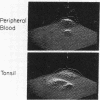Abstract
Two human B-cell differentiation antigens, Bp35 and Bp50, apparently play distinct roles as signal receptors in B-cell activation. Monoclonal antibodies (mAbs) to either Bp35 or Bp50 deliver positive signals to B cells that stimulate their transition through the cell cycle. mAb to Bp35, like anti-immunoglobulin antibodies, functions principally to activate resting B cells to become competent to enter the G1 phase of the cell cycle. In contrast, mAb to Bp50, a 50-kDa polypeptide expressed on all B cells, functions to stimulate activated B cells to traverse the cell cycle. mAb to Bp35, like anti-immunoglobulin antibodies, activates tonsillar B cells and induces low levels of B-cell proliferation. In contrast, anti-Bp50 mAb alone neither activates B cells nor induces B cells to proliferate but, together with anti-Bp35 or anti-immunoglobulin, augments B-cell proliferation. In this respect the action of anti-Bp50 antibody resembles the activity of B-cell growth factor(s) (BCGF). As little as 0.05 microgram of anti-Bp50 per ml is needed to augment proliferation and, like BCGF, anti-Bp50 is effective even when added 12-24 hr after B cells are activated with anti-immunoglobulin or anti-Bp35. Without additional exogenous signals, anti-Bp35 and anti-Bp50 together induce strong proliferation of purified resting B cells. These results suggest that the Bp35 and Bp50 surface molecules function in the regulatory control of B-cell activation and progression through the cell cycle.
Full text
PDF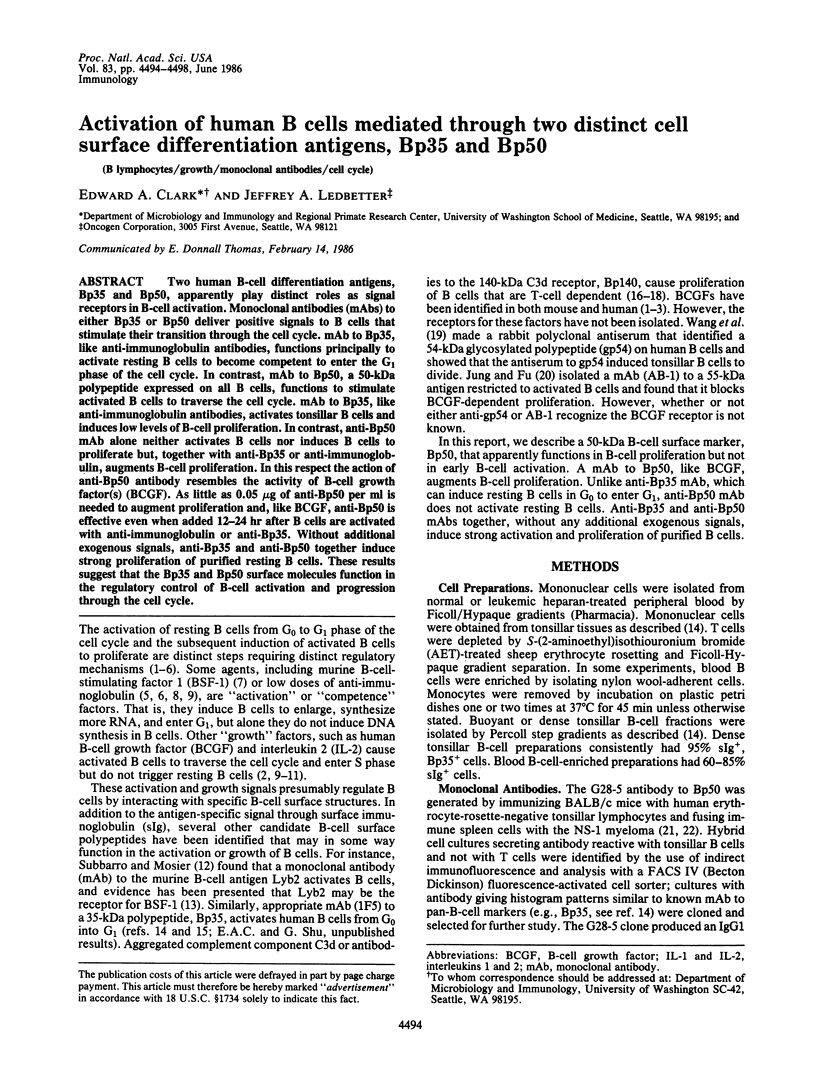

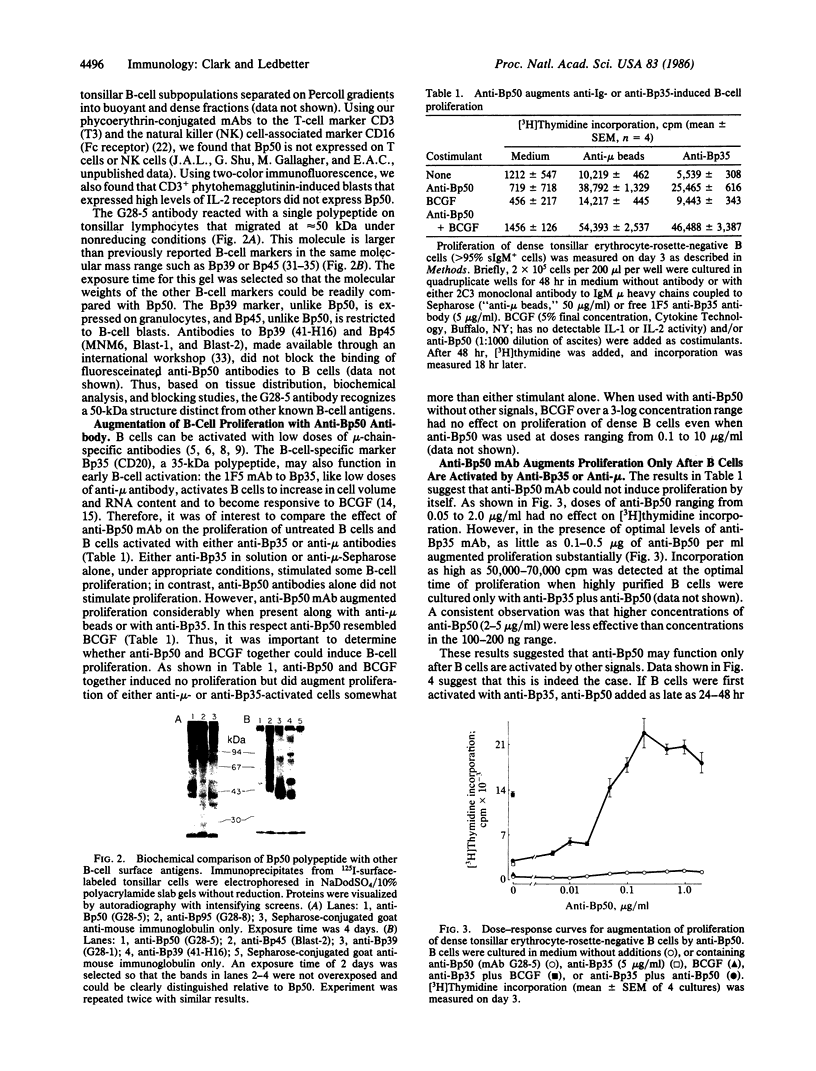
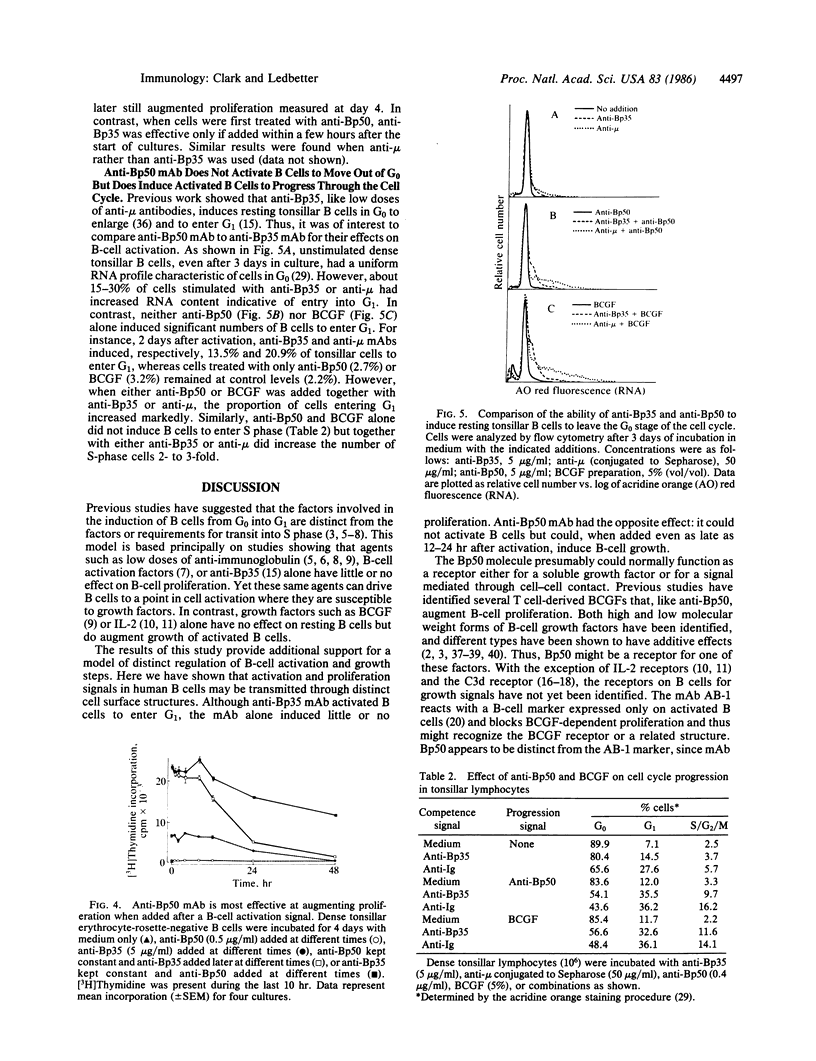
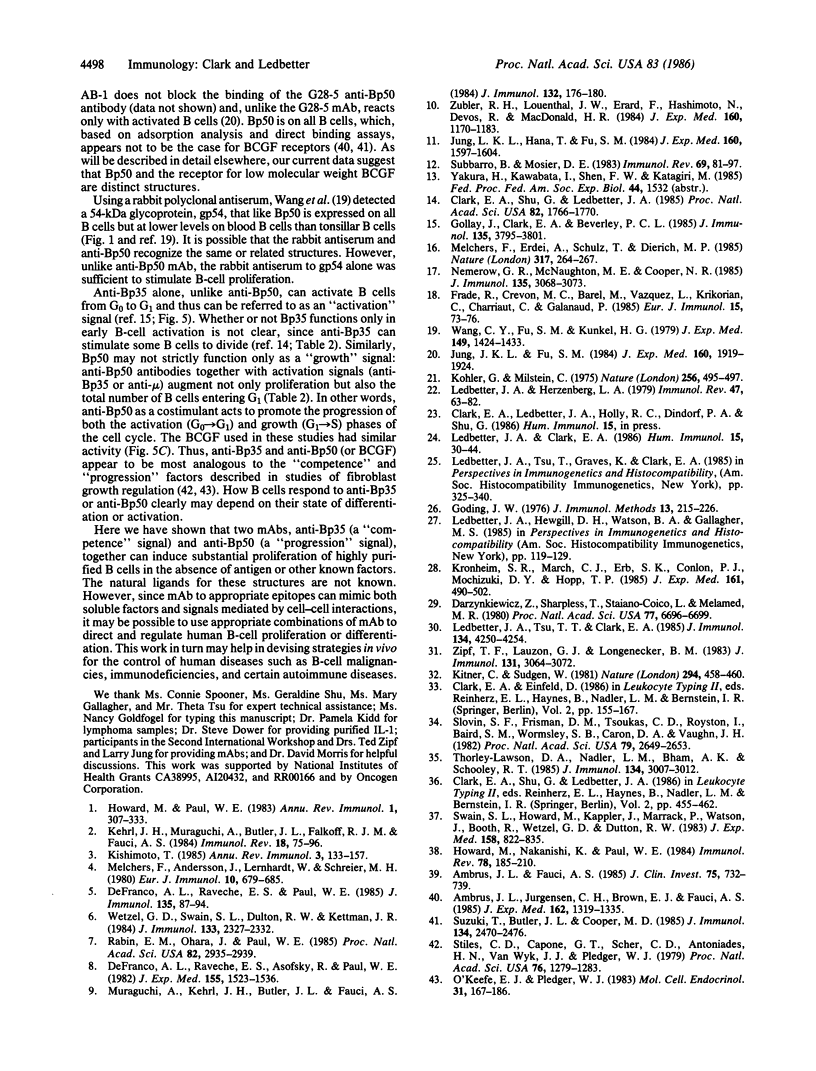
Images in this article
Selected References
These references are in PubMed. This may not be the complete list of references from this article.
- Ambrus J. L., Jr, Fauci A. S. Human B lymphoma cell line producing B cell growth factor. J Clin Invest. 1985 Feb;75(2):732–739. doi: 10.1172/JCI111754. [DOI] [PMC free article] [PubMed] [Google Scholar]
- Ambrus J. L., Jr, Jurgensen C. H., Brown E. J., Fauci A. S. Purification to homogeneity of a high molecular weight human B cell growth factor; demonstration of specific binding to activated B cells; and development of a monoclonal antibody to the factor. J Exp Med. 1985 Oct 1;162(4):1319–1335. doi: 10.1084/jem.162.4.1319. [DOI] [PMC free article] [PubMed] [Google Scholar]
- Clark E. A., Shu G., Ledbetter J. A. Role of the Bp35 cell surface polypeptide in human B-cell activation. Proc Natl Acad Sci U S A. 1985 Mar;82(6):1766–1770. doi: 10.1073/pnas.82.6.1766. [DOI] [PMC free article] [PubMed] [Google Scholar]
- Darzynkiewicz Z., Sharpless T., Staiano-Coico L., Melamed M. R. Subcompartments of the G1 phase of cell cycle detected by flow cytometry. Proc Natl Acad Sci U S A. 1980 Nov;77(11):6696–6699. doi: 10.1073/pnas.77.11.6696. [DOI] [PMC free article] [PubMed] [Google Scholar]
- DeFranco A. L., Raveche E. S., Paul W. E. Separate control of B lymphocyte early activation and proliferation in response to anti-IgM antibodies. J Immunol. 1985 Jul;135(1):87–94. [PubMed] [Google Scholar]
- Defranco A. L., Raveche E. S., Asofsky R., Paul W. E. Frequency of B lymphocytes responsive to anti-immunoglobulin. J Exp Med. 1982 May 1;155(5):1523–1536. doi: 10.1084/jem.155.5.1523. [DOI] [PMC free article] [PubMed] [Google Scholar]
- Frade R., Crevon M. C., Barel M., Vazquez A., Krikorian L., Charriaut C., Galanaud P. Enhancement of human B cell proliferation by an antibody to the C3d receptor, the gp 140 molecule. Eur J Immunol. 1985 Jan;15(1):73–76. doi: 10.1002/eji.1830150114. [DOI] [PubMed] [Google Scholar]
- Goding J. W. Conjugation of antibodies with fluorochromes: modifications to the standard methods. J Immunol Methods. 1976;13(3-4):215–226. doi: 10.1016/0022-1759(76)90068-5. [DOI] [PubMed] [Google Scholar]
- Golay J. T., Clark E. A., Beverley P. C. The CD20 (Bp35) antigen is involved in activation of B cells from the G0 to the G1 phase of the cell cycle. J Immunol. 1985 Dec;135(6):3795–3801. [PubMed] [Google Scholar]
- Howard M., Nakanishi K., Paul W. E. B cell growth and differentiation factors. Immunol Rev. 1984 Apr;78:185–210. doi: 10.1111/j.1600-065x.1984.tb00482.x. [DOI] [PubMed] [Google Scholar]
- Howard M., Paul W. E. Regulation of B-cell growth and differentiation by soluble factors. Annu Rev Immunol. 1983;1:307–333. doi: 10.1146/annurev.iy.01.040183.001515. [DOI] [PubMed] [Google Scholar]
- Jung L. K., Fu S. M. Selective inhibition of growth factor-dependent human B cell proliferation by monoclonal antibody AB1 to an antigen expressed by activated B cells. J Exp Med. 1984 Dec 1;160(6):1919–1924. doi: 10.1084/jem.160.6.1919. [DOI] [PMC free article] [PubMed] [Google Scholar]
- Jung L. K., Hara T., Fu S. M. Detection and functional studies of p60-65 (Tac antigen) on activated human B cells. J Exp Med. 1984 Nov 1;160(5):1597–1602. doi: 10.1084/jem.160.5.1597. [DOI] [PMC free article] [PubMed] [Google Scholar]
- Kehrl J. H., Muraguchi A., Butler J. L., Falkoff R. J., Fauci A. S. Human B cell activation, proliferation and differentiation. Immunol Rev. 1984 Apr;78:75–96. doi: 10.1111/j.1600-065x.1984.tb00477.x. [DOI] [PubMed] [Google Scholar]
- Kintner C., Sugden B. Identification of antigenic determinants unique to the surfaces of cells transformed by Epstein-Barr virus. Nature. 1981 Dec 3;294(5840):458–460. doi: 10.1038/294458a0. [DOI] [PubMed] [Google Scholar]
- Kishimoto T. Factors affecting B-cell growth and differentiation. Annu Rev Immunol. 1985;3:133–157. doi: 10.1146/annurev.iy.03.040185.001025. [DOI] [PubMed] [Google Scholar]
- Kronheim S. R., March C. J., Erb S. K., Conlon P. J., Mochizuki D. Y., Hopp T. P. Human interleukin 1. Purification to homogeneity. J Exp Med. 1985 Mar 1;161(3):490–502. doi: 10.1084/jem.161.3.490. [DOI] [PMC free article] [PubMed] [Google Scholar]
- Köhler G., Milstein C. Continuous cultures of fused cells secreting antibody of predefined specificity. Nature. 1975 Aug 7;256(5517):495–497. doi: 10.1038/256495a0. [DOI] [PubMed] [Google Scholar]
- Ledbetter J. A., Clark E. A. Surface phenotype and function of tonsillar germinal center and mantle zone B cell subsets. Hum Immunol. 1986 Jan;15(1):30–43. doi: 10.1016/0198-8859(86)90315-0. [DOI] [PubMed] [Google Scholar]
- Ledbetter J. A., Herzenberg L. A. Xenogeneic monoclonal antibodies to mouse lymphoid differentiation antigens. Immunol Rev. 1979;47:63–90. doi: 10.1111/j.1600-065x.1979.tb00289.x. [DOI] [PubMed] [Google Scholar]
- Ledbetter J. A., Tsu T. T., Clark E. A. Covalent association between human thymus leukemia-like antigens and CD8(Tp32) molecules. J Immunol. 1985 Jun;134(6):4250–4254. [PubMed] [Google Scholar]
- Melchers F., Andersson J., Lernhardt W., Schreier M. H. H-2-unrestricted polyclonal maturation without replication of small B cells induced by antigen-activated T cell help factors. Eur J Immunol. 1980 Sep;10(9):679–685. doi: 10.1002/eji.1830100905. [DOI] [PubMed] [Google Scholar]
- Melchers F., Erdei A., Schulz T., Dierich M. P. Growth control of activated, synchronized murine B cells by the C3d fragment of human complement. Nature. 1985 Sep 19;317(6034):264–267. doi: 10.1038/317264a0. [DOI] [PubMed] [Google Scholar]
- Muraguchi A., Kehrl J. H., Butler J. L., Fauci A. S. Sequential requirements for cell cycle progression of resting human B cells after activation by anti-Ig. J Immunol. 1984 Jan;132(1):176–180. [PubMed] [Google Scholar]
- Nemerow G. R., McNaughton M. E., Cooper N. R. Binding of monoclonal antibody to the Epstein Barr virus (EBV)/CR2 receptor induces activation and differentiation of human B lymphocytes. J Immunol. 1985 Nov;135(5):3068–3073. [PubMed] [Google Scholar]
- O'Keefe E. J., Pledger W. J. A model of cell cycle control: sequential events regulated by growth factors. Mol Cell Endocrinol. 1983 Aug;31(2-3):167–186. doi: 10.1016/0303-7207(83)90147-8. [DOI] [PubMed] [Google Scholar]
- Rabin E. M., Ohara J., Paul W. E. B-cell stimulatory factor 1 activates resting B cells. Proc Natl Acad Sci U S A. 1985 May;82(9):2935–2939. doi: 10.1073/pnas.82.9.2935. [DOI] [PMC free article] [PubMed] [Google Scholar]
- Slovin S. F., Frisman D. M., Tsoukas C. D., Royston I., Baird S. M., Wormsley S. B., Carson D. A., Vaughan J. H. Membrane antigen on Epstein--Barr virus-infected human B cells recognized by a monoclonal antibody. Proc Natl Acad Sci U S A. 1982 Apr;79(8):2649–2653. doi: 10.1073/pnas.79.8.2649. [DOI] [PMC free article] [PubMed] [Google Scholar]
- Stiles C. D., Capone G. T., Scher C. D., Antoniades H. N., Van Wyk J. J., Pledger W. J. Dual control of cell growth by somatomedins and platelet-derived growth factor. Proc Natl Acad Sci U S A. 1979 Mar;76(3):1279–1283. doi: 10.1073/pnas.76.3.1279. [DOI] [PMC free article] [PubMed] [Google Scholar]
- Subbarao B., Mosier D. E. Lyb antigens and their role in B lymphocyte activation. Immunol Rev. 1982;69:81–97. doi: 10.1111/j.1600-065x.1983.tb00450.x. [DOI] [PubMed] [Google Scholar]
- Suzuki T., Butler J. L., Cooper M. D. Human B cell responsiveness to B cell growth factor after activation by phorbol ester and monoclonal anti-mu antibody. J Immunol. 1985 Apr;134(4):2470–2476. [PubMed] [Google Scholar]
- Swain S. L., Howard M., Kappler J., Marrack P., Watson J., Booth R., Wetzel G. D., Dutton R. W. Evidence for two distinct classes of murine B cell growth factors with activities in different functional assays. J Exp Med. 1983 Sep 1;158(3):822–835. doi: 10.1084/jem.158.3.822. [DOI] [PMC free article] [PubMed] [Google Scholar]
- Thorley-Lawson D. A., Nadler L. M., Bhan A. K., Schooley R. T. BLAST-2 [EBVCS], an early cell surface marker of human B cell activation, is superinduced by Epstein Barr virus. J Immunol. 1985 May;134(5):3007–3012. [PubMed] [Google Scholar]
- Wang C. Y., Fu S. M., Kunkel H. G. Isolation and immunological characterization of a major surface glycoprotein (gp54) preferentially expressed on certain human B cells. J Exp Med. 1979 Jun 1;149(6):1424–1437. doi: 10.1084/jem.149.6.1424. [DOI] [PMC free article] [PubMed] [Google Scholar]
- Wetzel G. D., Swain S. L., Dutton R. W., Kettman J. R. Evidence for two distinct activation states available to B lymphocytes. J Immunol. 1984 Nov;133(5):2327–2332. [PubMed] [Google Scholar]
- Zipf T. F., Lauzon G. J., Longenecker B. M. A monoclonal antibody detecting a 39,000 m.w. molecule that is present on B lymphocytes and chronic lymphocytic leukemia cells but is rare on acute lymphocytic leukemia blasts. J Immunol. 1983 Dec;131(6):3064–3072. [PubMed] [Google Scholar]
- Zubler R. H., Lowenthal J. W., Erard F., Hashimoto N., Devos R., MacDonald H. R. Activated B cells express receptors for, and proliferate in response to, pure interleukin 2. J Exp Med. 1984 Oct 1;160(4):1170–1183. doi: 10.1084/jem.160.4.1170. [DOI] [PMC free article] [PubMed] [Google Scholar]



